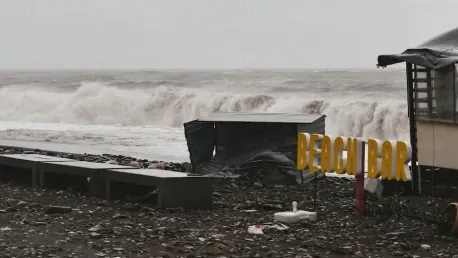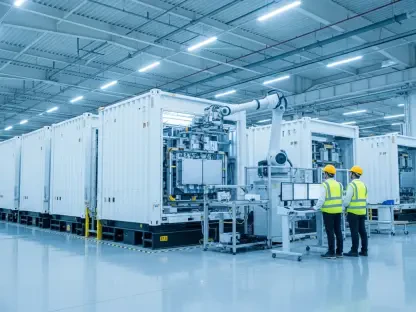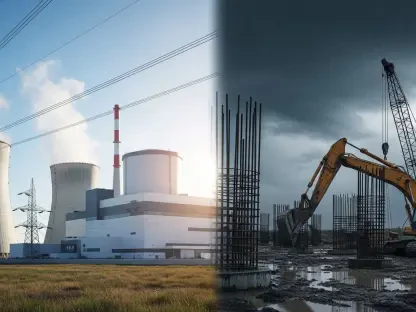The aftermath of Hurricane Helene has left the power grid infrastructure in the U.S. Southeast and Mid-Atlantic regions in tatters. As residents and utility companies grapple with the widespread destruction, the magnitude of the challenge to restore power becomes glaringly evident. This catastrophic event is marked as the most destructive hurricane in Georgia Power’s history, significantly impacting utility systems and leaving about 2 million customers without power.
The Severity of Helene’s Impact
Hurricane Helene, categorized as a Category 4 storm when it made landfall, wreaked havoc across ten states, particularly South Carolina, North Carolina, and Georgia. Winds reaching extraordinary velocities and torrential rain resulted in widespread power outages, initially affecting nearly 6 million customers. The devastation forced many into darkness, and despite the ongoing restoration efforts, around 2 million customers still remain without power.
The ferocity of the storm knocked down thousands of utility poles and heavily damaged hundreds of electric transformers. The resulting scene has been described by utility workers as nothing short of catastrophic. Roads were rendered impassable by fallen trees and debris, compounded by historic flooding and large-scale mudslides, particularly in vulnerable areas of the Carolinas. Factoring in the combination of widespread and severe disruption, it’s apparent that Helene’s impact has been unprecedented for the region.
Enormous Challenges in Restoring Power
Restoring power in the wake of Hurricane Helene presents a daunting task for utility companies. The primary obstacle lies in accessing the hardest-hit areas. Many regions, particularly rural zones, are cut off by washed-out roads and bridges submerged under floodwaters. Utility teams are facing delays due to these accessibility issues, making the task of clearing debris and beginning repairs exceedingly challenging.
Adding to these challenges, the extensive damage has necessitated the coordination of vast numbers of utility workers converging from various states. This massive deployment of resources aims to expedite the restoration process but also strains logistical capabilities, requiring a meticulous allocation of manpower, equipment, and materials. Teams are working around the clock to restore power, yet the sheer scale of the damage means that many customers will be waiting weeks, if not months, before full electricity is restored.
Rebuilding the Infrastructure from Scratch
In the areas most severely impacted by Hurricane Helene, the damage is so extensive that mere repairs are not an option. These regions require a complete reconstruction of their electrical systems. The task at hand includes rebuilding entire substations, replacing thousands of utility poles, and either repairing or replacing damaged transformers.
For instance, Duke Energy, one of the hardest-hit utility companies, reported that in some locations, substations were inundated with water, leading to the need for complete refurbishment. The damage has been so extensive that some suburban and rural areas face different restoration needs, with some requiring new power lines and others needing comprehensive system overhauls. Given the scope of this rebuilding effort, utility companies are bracing for a long and arduous recovery process.
Technological and Logistical Responses
In response to this unprecedented challenge, utility companies are deploying advanced technological solutions to expedite recovery. The integration of smart grid technologies allows for quicker identification of fault locations and more efficient responses. Response teams were pre-positioned ahead of the hurricane’s landfall, a measure that has proven effective in quicker mobilization and a more organized approach to restoration.
Additionally, helicopters and drones are being utilized for aerial assessments, providing real-time insights into damaged areas that are otherwise inaccessible. These technologies offer a safer and faster means to evaluate the extent of destruction, helping to prioritize restoration efforts. With infrastructure devastated by flooding and high winds, being able to quickly assess and address the most pressing damage is crucial for getting power restored to the greatest number of people as quickly as possible.
Collaborative Efforts and Community Support
The collaborative efforts of utility companies, state authorities, and local communities are pivotal in this immense restoration task. Mutual aid agreements among utilities have allowed for an influx of additional manpower and resources from neighboring states. These collaborations facilitate a more organized and efficient restoration process, as companies share equipment, expertise, and manpower to tackle the widespread destruction.
Community support has also been invaluable, with residents showing resilience and patience despite the prolonged outages. Local volunteers are stepping in to aid utility crews by clearing debris, providing critical support at a time when manpower is stretched thin. The collective effort, from professional utility workers to ordinary citizens, underscores a united front against the catastrophic damage inflicted by Hurricane Helene.
The Road Ahead: Long-Term Solutions
Hurricane Helene has wreaked havoc on the power grid infrastructure in the Southeastern and Mid-Atlantic regions of the United States. This devastating storm has left utility companies and residents wrestling with the extensive damage and shattered electric systems. The unbelievable extent of the damage underscores the monumental effort required to restore power. Notably, this hurricane is being recorded as the most destructive natural event in the history of Georgia Power, leading to an unprecedented impact on utility systems and leaving roughly 2 million customers in the dark.
In the days following the hurricane, teams of engineers and technicians are working around the clock to repair downed lines and destroyed substations. Emergency response teams and utility workers from other states have been dispatched to aid in the massive recovery effort. The work is arduous and dangerous, involving clearing debris and ensuring safety while attempting to re-establish power. Communities are rallying together, providing support and care to those most affected, but the road to full recovery is expected to be long and challenging. As people cope with the immediate fallout, the focus remains on restoring power and rebuilding stronger, more resilient infrastructure to better withstand future storms.









